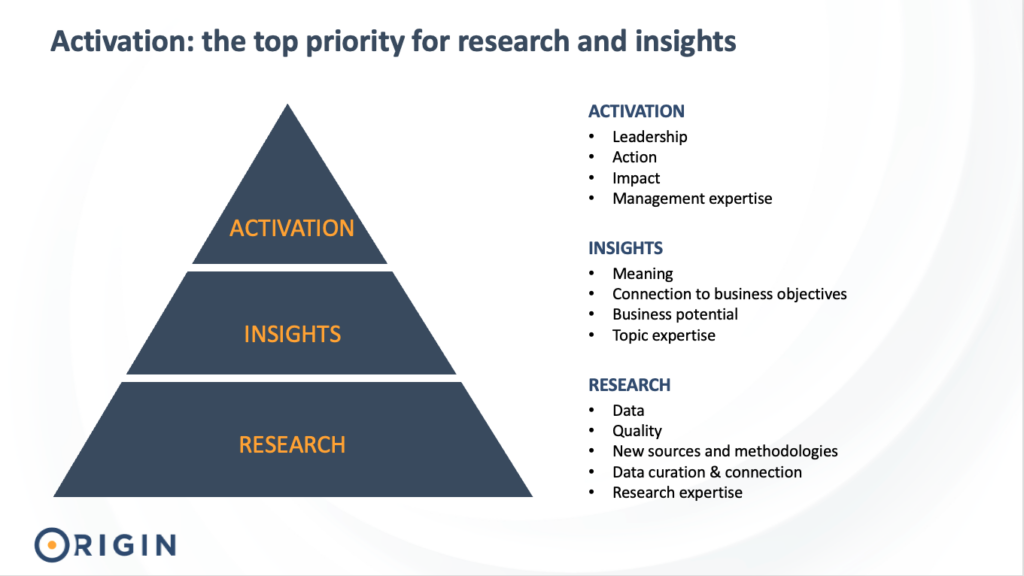
A number of hot topics are dominating the conversation about what will be key in market research and insights in 2025. Sure, the role of AI, the rise of synthetic respondents and the quest for better data quality will continue to be extremely important to many professionals in our industry. But if you ask a few CEOs what they want from market research in 2025, I bet only a fraction of them will mention any of these. They might be more interested in getting more impact from their insights budget. And if there is one thing that can make a difference in terms of impact, it is insight activation.
Insight activation. What it is and why it matters
Insight activation is the process of integrating research findings into business plans and using them to improve business performance. Even the best insights, the ones that are truly new, groundbreaking and have a lot of transformative potential, are just ideas on a paper until they are used to drive action. After all, activation is why insights are created in the first place, isn’t it?
Turning insights into action should be easy, but it is not. Some insights don’t make it into business plans. When this happens, some of the company’s resources have been spent with no return. Worse still, the business may be making decisions with an incomplete picture, which can affect business performance. Avoiding this lack of activation requires a lot of alignment across the organisation and strong leadership from the owner of the insights function.
Building for activation success
Activation is considered by many professionals to be the ‘last mile’ of research. Once the insight has been discovered, it must be communicated as compellingly as possible in the right forums to become a priority for the team in charge of execution.
This will work in some cases, but in my experience, thinking about activation after the insights have been created makes the alignment very dependent on the specific case. In my view, successful activation of insights should start well before that, and needs to be seen as a broader, ongoing effort. The whole organisation should be living and breathing the insights, 365 days a year, so that when they need to be put into practice, it is the natural step.
Your annual insights plan
If you conduct research on a regular basis, you need to plan how your insights budget will be spent to maximise its return. And activation should be considered from the very first moment you think in terms of insights.
- Put your business’ objectives at the heart of your plan. Make sure it is aligned with the business strategy and that you prioritise actions in a way that your stakeholders can see their influence in the final plan. This will make it easier to move to activation successfully.
- Engage your allies as early as possible. Have the right conversations with those you think can influence the activation. Find out what is important to them and what to avoid in order to get them on board.
- Adapt when necessary. Once you are in the execution phase, find a good balance between sticking to the plan and adapting to new situations. This will help you stay on strategy while showing flexibility and ensuring that no one feels left behind.
- Emphasise the importance of insights to business success. Communicate regularly about their contribution. Making the organisation aware of the value of insights is good for making the business more customer-centric and is a key responsibility of the owner of the function, whether it is the CMI or the CMO.
Before a research project starts
Fostering alignment and buy-in is not a one-off task, and the work done to create the plan should continue throughout the year, especially each time a new project starts
- Activation-first project design. What will the study be used for? What actions will be taken? If all teams are aligned on this, everything else will follow. I often use in-depth interviews at this stage. One-to-one conversations make it easier to identify needs and, pain points and concerns that need to be addressed during the project.
- Scope the specifics of the survey. Workshops with all teams potentially involved in the implementation are very useful to get buy-in for the details. They help to bring to the surface any conflicts of interest or differences in expectations that can be managed. If something can’t be covered by the project, it should be clear at the outset to avoid disappointment.
During the project
Regularly update everybody on progress and make sure you keep them interested in the study. If there is going to be a delay, let them know in advance so they can adjust their expectations and timeframe.
At the end of the project
The long-awaited moment has arrived and all the findings are revealed.
- Communicate with all your stakeholders. Anyone involved in discussions about the project or with a role in activation should be targeted in your communications. But also any other stakeholders who might simply benefit from knowing more about the customer or about the power of insights to inform decision making.
- Create a narrative. Data may excite some, but human stories are more likely to engage. Build a narrative that uses data to support key points.
- Deliver with impact. Avoid endless presentations of bar charts. Less is often more. And don’t limit yourself to formal presentations. Video is a great way to put some meat on the bones and tends to be very effective with senior executives. You can produce one-pagers and infographics if you want to disseminate the key findings widely and have a lasting impact. Posters, installations, competitions and a few other mechanics will help you reach people on a large scale in informal and unexpected ways. Combine several of these touchpoints for greater impact.
- Create a repository of insights for future reference. Many projects, especially the most foundational ones, may help people in the future to make decisions. Ensure that insights are easy to access and available to all the relevant people across the organisation.
- Help plan what to do next. Now that you have the insight, it is time to act on it. Organise “so what” workshops to discuss activation options with all relevant people. Make sure you get solid plans, everyone’s buy-in and complete clarity about what needs to be done, by whom and by when.
- Overlook execution. At the start of the project, you invited all relevant stakeholders to help define the research project. Now it is time to claim your involvement in the activation phase. This will help you continue to bring the voice of the consumer into the initiatives that are taking place and ensure that the team does not get distracted from what matters to your customers.
Where to start?
Hopefully, these tips will help you put your insights at the heart of your organisation and prepare for a successful activation. And if it looks like a Herculean task, don’t worry. Engaging all stakeholders in activation was my bread and butter when I ran insights functions for large global companies. Now, through Origin Insights, I help others do the same. Whether you want to run alignment workshops or need help disseminating your insights across the organisation, we can help. Give me a call and we’ll work out the best way forward.

Mar Serrán
Want to increase the impact of your insights?


